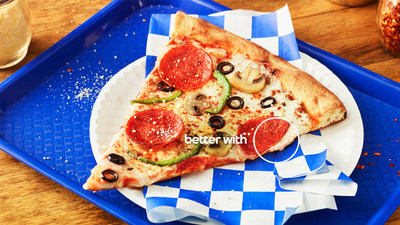
Are you a Coca-Cola person? Are you a Pepsi person? Or are you a “ I only drink water” person? Whatever side you lie on when it comes to the Cold (Cola) War between the two soft drink giants, Pepsi and Coca-Cola, what really worked for them is their way to market themselves, especially their not-so-subtle digs at each other.
After a period of relative calm between the two brands, the battle has been reignited, fueled by Pepsi’s recent rebrand and a bold new social media strategy. For any branding agency, this modern-day feud is a masterclass for using nostalgia, humour and a challenger brand mindset to capture consumer attention
Table of Contents:
- A Nostalgic New Identity: The 2023 Rebrand
- The Strategy: Unleashing the Challenger Mindset
- The Trolling Game: A History of Taking on Goliath
- What Else is New?
- Final Thoughts
- Frequently Asked Questions
A Nostalgic New Identity: The 2023 Rebrand
In 2023, Pepsi unveiled its first major rebrand in 14 years, introducing a bold, new logo that pays homage to its iconic visual identity from the 1970s and 80s. According to a press release from PepsiCo , the new design aims to “connect future generations with the brand’s heritage” by integrating distinctive historical markers with contemporary elements.
The key elements of the rebrand include:
- A bold typeface that aligns the wordmark with the iconic Pepsi Globe, a feature absent in the previous 2008 design.
- An updated colour palette that adds black, a visual cue to highlight the brand’s commitment to its Pepsi Zero Sugar product line.
- A “signature pulse” that brings movement and energy, designed to be more flexible and dynamic for digital and physical spaces, from retail shelves to the metaverse.
As Mauro Porcini, SVP & Chief Design Officer of PepsiCo, stated , “We designed the new brand identity to connect future generations with our brand’s heritage, marrying distinction from our history with contemporary elements to signal our bold vision for what’s to come,” as reported by Pepsico in their press release. This strategic nod to nostalgia, while still looking toward the future, was a calculated move to reconnect with both older consumers who remember the brand’s heyday and younger generations who are drawn to retro aesthetics.
The Strategy: Unleashing the Challenger Mindset
Pepsi has always positioned itself as the challenger brand to Coca-Cola’s established leader status. Its new brand identity is a physical manifestation of this mindset and its social media content is where this strategy truly comes alive.
The core of their approach can be broken down into three key pillars:
Directly Engaging the Competition
Instead of ignoring Coca-Cola, Pepsi leans into the rivalry with humorous, cheeky and direct jabs on social media and in print ads. A notable recent example is a print ad in The Times of India that read, “Anytime is Pepsi Time,” as a direct rebuttal to Coke’s “Half Time” campaign that aimed to own the breaks in sports.
Using Humour and Relatability
The brand’s content often uses memes, witty comebacks and relatable scenarios to position itself as the cool, rebellious alternative. Another key example is the “Better with Pepsi” campaign from 2021, for which it also won a D&AD award , ran heavily on Instagram and YouTube. The campaign used print and digital visuals showing the logos of fast-food chains like McDonald’s and Burger King subtly hidden in the shape of a Pepsi logo, implying their burgers taste better with Pepsi. This strategy was not only witty but also encouraged user-generated content and widespread sharing.
Capitalising on Cultural Moments:
In a recent campaign, timed to National Barbecue Day, Pepsi launched “BBQ Crashers,” where a group of “Pepsi Crashers” hilariously show up uninvited to cookouts to swap out Coke for Pepsi. This type of real-time, event-based marketing allows the brand to be part of the cultural conversation.

Rather than just selling a product, this strategy leverages the cultural phenomenon of the “Cola Wars” to build a community of ‘rebels’. By engaging in playful banter and meme-worthy content, Pepsi cultivates a brand identity that is less about what it sells and more about the conversation it starts. It’s a powerful lesson for any digital marketing agency on how to use social media not just for reach, but for deep, community-driven engagement.
The Trolling Game: A History of Taking on Goliath
Pepsi’s new trolling tactics are a throwback to some of its most successful campaigns, with a history of using clever marketing to overshadow official sponsors. The “Pepsi Challenge” blind taste test remains a famous example of directly challenging its rival on taste. However, for a masterclass in modern rivalry, look no further than its legendary “Nothing Official About It” campaign.
This campaign is a textbook example of ambush marketing, a strategy where a brand associates itself with an event without paying to be an official sponsor. In 1996, while Coca-Cola paid a hefty sum to secure the official sponsorship of the Cricket World Cup, Pepsi turned its competitor’s victory into its own marketing triumph.
Pepsi’s creative team, led by a young writer named Anuja Chauhan, realised that Coke’s official status was a weakness they could exploit. They created a campaign featuring cricket icons like Sachin Tendulkar, who were under contract with Pepsi. The ads showed these stars in candid, “unscripted” moments, with the iconic tagline, “Nothing Official About It.” This move brilliantly positioned Pepsi as the brand of the players and the fans, the “unofficial” drink of the tournament, in stark contrast to Coke’s stuffy, “official” status
Since Coca-Cola bagged the official sponsorship rights to the 1996 Wills World Cup, its rival Pepsi, in a classic case of ambush marketing, launched a campaign with the tagline: “Nothing official about it”. With SRT's face next to the tagline, of course the campaign worked. pic.twitter.com/5agMHn6Rzr
— TheRandomCricketPhotosGuy (@RandomCricketP1) March 2, 2023
What Else is New?
In addition to reigniting the “Cola Wars,” the 2023 rebrand is a strategic move to position Pepsi as a future-forward brand for the next generation of consumers, particularly Gen Z. The new visual identity goes beyond a simple logo update. It introduces a modern, uppercase typeface that, as reported by Design Week , is designed to be unapologetically bold and confident. The refreshed colour palette adds an electric blue and, most notably, black, to emphasise the brand’s growing focus on its Pepsi Zero Sugar product line.
Perhaps the most innovative change, however, is the introduction of an audio-enhanced identity . The brand has developed a unique sound toolkit or “signature pulse,” that evokes the “ripple, pop and fizz” of the drink itself. This audible branding is designed to be flexible and dynamic, allowing Pepsi to create a consistent identity across all digital and physical touchpoints, from a television commercial to a quick TikTok video. This move demonstrates that Pepsi’s rebrand is about more than just a new look; it’s about building a fully immersive and multi-sensory brand experience for a digitally-native audience.
Final Thoughts
The next time you’re faced with the eternal question of “Coke or Pepsi?” Ask yourselves, are you a fan of a little bit of nostalgia with a big dose of sarcasm? If yes, you’ve already found your answer. The “Cola Wars” have returned and this time, the battlefield is digital. With its nostalgic rebrand and a witty social media strategy, Pepsi is proving that a well-defined brand identity and a challenger mindset can be more powerful than a larger marketing budget and we, as a Digital Marketing agency , can only appreciate the sheer geniuses that were behind this rebrand.



